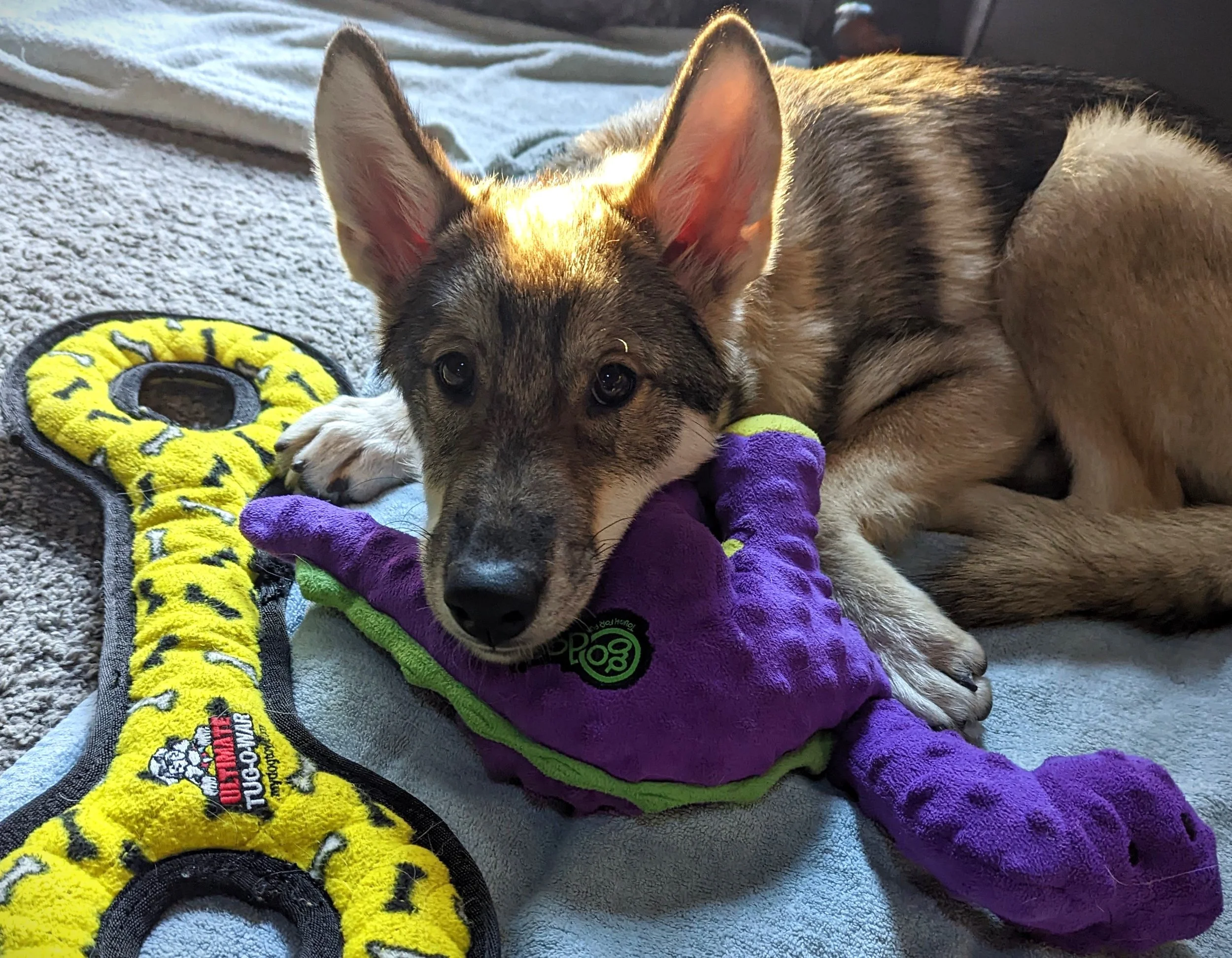Mastering Chewing Behavior: 3 Essential Tips for Satisfying Your Pup’s Chew Cravings
Every morning Katara wakes up ready to play and explore everything in front of her with her mouth first. She loves grabbing her favorite toy to play with or finding a stick in the yard to gnaw on. Chewing is a natural behavior for her, but sometimes it can lead to unwanted outcomes for us and a good few shredded toys or dog beds. Asher and Bokeo were also very mouthy a their young age, resulting in replacement window blinds and a new couch, among other favored items.
Whether you have a puppy who’s teething or an adult husky with a strong chew instinct, addressing chewing behavior is crucial for maintaining a happy husky and your own sanity. Having a super chewer is no small feat and coming up with ways to distract them from putting their mouths on your favorite furniture is a constant battle. Finding durable and safe options to satisfy your pup’s chewing instincts is a must. Here are some tips on how we’ve managed to control our huskies’ constant need for chewing and ensure a safe and happy environment for our mouthy pups.
Stock Up On Chewing Treats and Toys
One of the most effective ways that I’ve used to prevent Katara’s destructive chewing is to provide her with enticing, high-value chew toys and treats. By offering a variety of safe and durable options, I can redirect her natural instinct to chew toward a toy or snack of my choice. We use high-quality chew toys such as rubber Kongs, Nylabones, or interactive puzzles for continuous mental stimulation. Sometimes I throw a Kong in the freezer with peanut butter to lengthen Katara’s play time. This keeps her mentally stimulated and her teeth off of our dining room chairs.
Our favorite chew-worthy treats:
Our favorite durable chew toys:
2. Combine Training and Chewing Activities
Since bully sticks, marrow bones, antlers, and yak chews are such high-reward snacks for Katara, we use them to entice her into ‘crate time’ as an added training bonus. Since it takes her longer to finish these tasty treats, she spends that bonus time focused on training and learning that she gets rewarded for being calm in her crate. We have also taught Katara to take her antlers and bones back into the crate if she removes them to chew elsewhere around the house. We did this by putting the antler or bone in her mouth, telling her “Go to your crate”, and leading her back to the crate when she tried to leave with her favorite snack. It takes some time, but repetitive reinforcement is key to accomplishing this command. If you are not crating your pup, you can also use this command to train your dog to keep their chew on their bed. Learning this command has helped Katara learn healthy boundaries as well as know when and where she can satisfy her chewing behavior. I also no longer have to deal with frozen marrow bone juice smeared all over our pricey couch!
Teaching “leave it” or “drop it” commands can be especially helpful when giving your dog structured chew time and we use these phrases often on walks. These commands can help you to take control of situations where your dog is about to chew something they shouldn’t. When our dogs follow these commands, I reward them with a special toy, chew, or a training treat to reinforce their positive behavior.
3. Prevent Opportunities for Unwanted Chewing
As huskies and other arctic breeds are naturally curious in nature, preventing opportunities for inappropriate chewing is a key aspect of keeping your living space (and your sanity) intact. While constant supervision isn’t always possible, you can create a barrier or “puppy-proof” your home to prevent unwanted destructive behaviors. This may involve using baby gates, crate training, or creating designated play areas to limit your pup’s access to potential temptations. When Asher was a puppy, I used baby gates to section off parts of the house to prevent him from getting access to areas where he would tend to follow his mouth if left unsupervised. He was also crate-trained, like Katara is now, to prevent destructive behaviors when left at home.
Making sure your home is “dog-proofed” will also help to curb unwanted chewing behaviors. Put away any toys, shoes, or valued items that you don’t want to be damaged or you notice your dog is particularly interested in when you are at home. Asher liked to gnaw on my pillows, jackets, or other items with my scent during bouts of separation anxiety so I learned to store them out of reach before leaving the house. Consistency in your approach to the prevention of chewing behaviors and having a good “dog-proofed” home is essential for your dog’s training and avoids confusion for them on what they think is a toy, when really it’s your favorite pair of shoes.
Mastering your husky’s chewing behavior doesn’t have to be a frustrating ordeal. By keeping a well-stocked cabinet of treats and toys, you can curb your pup’s natural instinct to chew towards more appropriate items of your choice. Establishing clear boundaries and employing effective training methods are crucial for instructing your dog when and where to chew, leaving you with a happy pup and your favorite shoes intact!
***On this page are product recommendations that help promote a happy and healthy lifestyle for you and your dog. Our Husky Life is a participant in the Amazon Services LLC associates program. As an Amazon Associate, Our Husky Life earns from qualifying purchases.***






